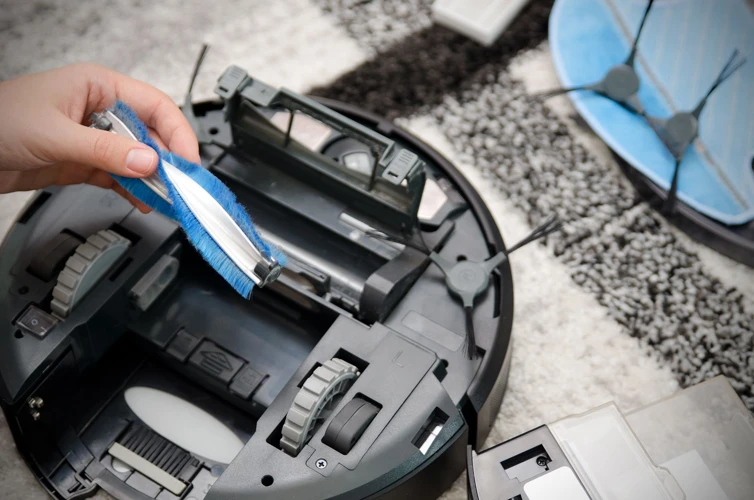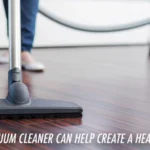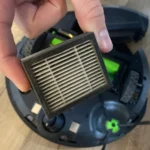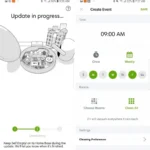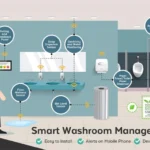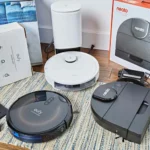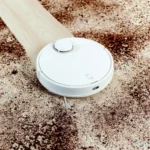Are you tired of spending countless hours vacuuming your floors? Multi-floor robot vacuum cleaners are a blessing in disguise, but without proper maintenance and care, their performance could decline. Keeping your robot vacuum clean and healthy not only prolongs its life but also ensures that your floors are free from dirt and debris. In this article, we’ll take a detailed look at the essential maintenance and care tips for your multi-floor robot vacuum cleaner. From cleaning the dustbin and sensors to caring for the battery, we’ve got you covered. So sit tight and let’s dive into the world of robot vacuum maintenance.
Why Maintenance and Care is Essential for Your Multi-Floor Robot Vacuum Cleaner
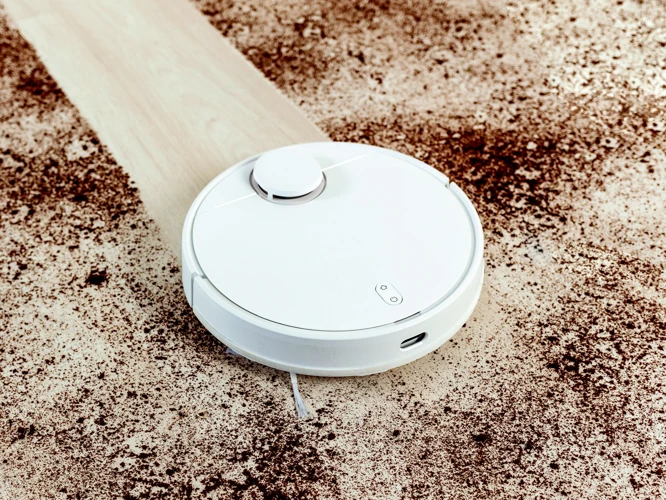
As a proud owner of a multi-floor robot vacuum cleaner, you already know the benefits of having such a smart device clean your home without the slightest effort on your part. However, to maintain its optimal performance and prolong its lifespan, regular maintenance and care are essential. After all, a well-maintained robot vacuum cleaner ensures a healthy and clean living environment while saving you time from doing the cleaning yourself. In this article, we’ll guide you through some easy steps to keep your multi-floor robot vacuum cleaner functioning at its best! Check out our recommendations on some of the best multi-floor robot vacuums to ensure efficient and seamless cleaning of your home.
Prolongs the Life of Your Vacuum
Proper maintenance and care of your Multi-Floor Robot Vacuum Cleaner is crucial to prolonging its lifespan. Neglecting to maintain and care for your vacuum cleaner may cause irreparable damage that could have been avoided with timely and consistent care.
Regular cleaning of your vacuum not only ensures its longevity but also its optimal performance. A malfunctioning vacuum can be frustrating and costly to fix. It’s essential to follow a maintenance routine to keep your multi-floor robot vacuum running at peak performance.
The following table illustrates the different care tips that can help prolong the life of your multi-floor robot vacuum cleaner:
| Care Tips | Description |
|---|---|
| Empty the Dustbin Regularly | The dustbin of your robot vacuum cleaner should be emptied frequently to prevent it from getting too full, which could lead to suction problems. |
| Clean the Brushes and Filters | The brushes and filters of your robot vacuum cleaner can get clogged with hair, dirt, and dust. Clean them regularly to maintain optimal performance. |
| Clean the Sensors | The sensors of your robot vacuum cleaner can get dirty, which can interfere with its ability to navigate around your home. Clean the sensors regularly to ensure it operates effectively. |
| Keep the Charging Station Clean | The charging station of your robot vacuum cleaner should be kept clean to ensure it charges properly. Remove any debris or dirt from the charging contacts. |
| Inspect the Wheels and Tires | The wheels and tires of your robot vacuum cleaner can get clogged with debris or hair, leading to less effective cleaning. Inspect them regularly to ensure they are clean and functioning correctly. |
By following these maintenance tips, you can ensure your multi-floor robot vacuum cleaner remains in top condition, allowing you to enjoy its benefits for years to come.
Not taking care of your multi-floor robot vacuum cleaner can hinder its adaptation to different floors, which could lead to poor cleaning performance. If you want to know more about how multi-floor robot vacuums adapt to different floors, you can check out this article.
Regular maintenance and care can help you avoid costly repairs and ensure your multi-floor robot vacuum cleaner remains one of the most popular vacuum robots on the market. For more helpful tips and information, check out this article on how to use your vacuum cleaner effectively.
Ensures Optimal Performance
Proper maintenance and care is crucial for ensuring the optimal performance of your multi-floor robot vacuum cleaner. Neglecting maintenance can lead to a decline in performance, reducing the effectiveness of your robot vacuum cleaner.
Regular cleaning of the dustbin, brushes, filters, and sensors help maintain optimal performance. When the dustbin is full, the vacuum’s suction power decreases, making it difficult to clean effectively. By cleaning it frequently, you ensure that the suction power remains high, which allows the robot vacuum to clean more efficiently.
Cleaning the brushes and filters at least once a week is important to improve the airflow, which enhances the suction power of your vacuum cleaner. This step ensures that your vacuum can capture more dust, debris, and other particles.
Cleaning the sensors is also paramount for optimal performance. Sensors help the vacuum map out a room, navigate around obstacles and avoid falling off stairs or ledges. A robot vacuum with dirty or damaged sensors can get stuck or fall down stairs or ledges, resulting in damage or injury. Clean the sensors regularly to make sure your vacuum operates safely and effectively.
Keeping the charging station clean is vital for optimal performance. Dust and debris can accumulate around the charging ports over time, hampering the charging process, and hence the cleaning schedule. Also, inspecting the wheels and tires of the robot vacuum cleaner regularly is essential for ensuring that the vacuum can move freely and navigate around obstacles effortlessly.
By following these maintenance tips, you can keep your robot vacuum performing optimally for years, ensuring a clean and healthy living environment for you and your family. If you want to learn more about the benefits of a multi-floor robot vacuum, check out our top features of a multi-floor robot vacuum guide or browse our list of popular vacuum robots.
Keeps Your Home Clean and Healthy
Maintaining and caring for your multi-floor robot vacuum cleaner does not only extend its lifespan and optimize its performance, it also ensures that your home stays clean and healthy. After all, a dirty robot vacuum can end up spreading more dirt and dust around your home than it cleans up.
Regular maintenance and care routines, such as emptying the dustbin, cleaning the brushes and filters, and inspecting the wheels, can significantly reduce the amount of dust, dirt, and contaminants that accumulate in your home.
Dust and Allergens
Multi-floor robot vacuums are designed to pick up dirt, dust, and other debris from your floors, but if the vacuum isn’t cleaned and maintained regularly, it can actually become a source of dust and allergens. As the vacuum moves around your home, it can spread dust and dirt from its filters and brushes onto your floors and furniture. This can be especially problematic for people with allergies or asthma.
Bacteria and Mold
Another concern with uncleaned robot vacuums is the potential for bacteria and mold buildup. When the dustbin and filters are not cleaned and emptied, they can become breeding grounds for bacteria and mold. This can lead to unpleasant odors and even pose a health risk to you and your family.
Benefits of a Clean Multi-Floor Robot Vacuum
Regular maintenance and care can help prevent the spread of dust, allergens, bacteria, and mold in your home. By keeping your multi-floor robot vacuum clean and regularly maintaining it, you can ensure that you are living in a healthy and hygienic environment.
Clean robot vacuums can generally clean more effectively and perform better since they are not clogged with dirt and dust. This means you can enjoy a cleaner home with less effort and time.
Learn more about the benefits of multi-floor robot vacuums and how they can save you time and energy in our previous article.
How to Maintain and Care for Your Multi-Floor Robot Vacuum Cleaner

Taking care of your multi-floor robot vacuum cleaner is crucial for ensuring optimal performance and efficient cleaning. Regular maintenance not only prolongs the lifespan of your device but also keeps your home free of dirt, dust, and allergens. Neglecting proper care and maintenance can lead to various issues such as decreased suction power, damaged brushes, and malfunctioning sensors. In this section, we will discuss several tips for taking care of your multi-floor robot vacuum cleaner to ensure it operates at peak performance for years to come.
Empty the Dustbin Regularly
It’s essential to empty the dustbin regularly to ensure your multi-floor robot vacuum cleaner performs optimally. The dustbin collects dust, dirt, hair, debris, and other particles while cleaning. If you don’t empty the dustbin, it can lead to clogging and affect the vacuum’s suction power. It’s recommended to empty the dustbin after every cleaning or once a day, depending on how much your robot vacuum cleaner cleans.
Here’s a simple html table that highlights the steps to empty the dustbin:
| Step | Description |
|---|---|
| Step 1 | Locate the dustbin on your robot vacuum cleaner |
| Step 2 | Press the release button to remove the dustbin from the vacuum cleaner |
| Step 3 | Carry the dustbin over to a trash can or bin |
| Step 4 | Open the dustbin lid or cover |
| Step 5 | Empty the contents of the dustbin into the trash |
| Step 6 | Close the dustbin lid or cover |
| Step 7 | Re-attach the dustbin to the vacuum cleaner |
By regularly following these steps to empty the dustbin, you can ensure that your multi-floor robot vacuum cleaner continues to perform optimally, giving you a clean and healthy home.
Clean the Brushes and Filters
To keep your multi-floor robot vacuum cleaner operating at optimal performance, it’s important to clean the brushes and filters regularly. Over time, dirt, hair, and debris can accumulate on these components, which can reduce your vacuum cleaner’s suction power and efficiency.
Here are the steps to follow to clean the brushes and filters of your multi-floor robot vacuum cleaner:
- Step 1: Turn off and unplug your vacuum cleaner
- Step 2: Remove the dustbin from the vacuum cleaner
- Step 3: Locate the brushes and filters
- Step 4: Remove the brushes by gently pulling them out of their housing
- Step 5: Use a brush or tool to remove any debris or hair that may be tangled around the brushes
- Step 6: Use a damp cloth or tissue to wipe the brushes clean
- Step 7: Allow the brushes to dry completely before reinserting them into the vacuum cleaner
- Step 8: Remove the filters from their housing
- Step 9: Tap the filters gently to remove any loose dust and debris
- Step 10: Rinse the filters under running water, ensuring that all dirt and debris is removed
- Step 11: Allow the filters to air-dry completely before placing them back into the vacuum cleaner
- Step 12: Reassemble the vacuum cleaner and turn it back on to resume cleaning
By regularly cleaning the brushes and filters of your multi-floor robot vacuum cleaner, you’ll not only keep it running smoothly, but also prolong its lifespan. Plus, with a clean vacuum cleaner, you’ll be able to maintain a healthier and more hygienic living space.
Clean the Sensors
When it comes to maintaining and caring for your multi-floor robot vacuum cleaner, cleaning the sensors is a critical part of ensuring optimal performance. The sensors are what guide the vacuum around your home and allow it to navigate obstacles and avoid falling down stairs.
To keep your vacuum’s sensors working correctly, you should follow these steps:
- First, make sure the vacuum is turned off and unplugged.
- Next, use a soft, dry cloth to wipe down the sensors. Be gentle and take care not to scratch or damage the sensors.
- If the sensors are particularly dirty or dusty, you can use a clean, dry toothbrush or paintbrush to gently remove any debris.
- Once you have cleaned the sensors, turn the vacuum back on and run it around your home to test its navigation capabilities. If you notice any issues, you may need to repeat the cleaning process.
Regularly cleaning the sensors of your multi-floor robot vacuum cleaner will help to ensure that it can effectively navigate around your home, avoiding obstacles and cleaning all necessary areas. By keeping the sensors clean, you can also prolong the life of your vacuum and prevent any damage or malfunctions. Remember that prevention is always better than cure, and a little bit of regular maintenance and care can go a long way in keeping your robot vacuum performing at its best.
Keep the Charging Station Clean
The charging station is an essential component of your multi-floor robot vacuum cleaner, as it’s where your machine charges and stores power between uses. Thus, it’s critical to keep the charging station clean to ensure optimal performance and longevity of your vacuum cleaner. Here are some tips on how to keep your charging station clean:
- Clean the Surface: First and foremost, you need to keep the charging station’s surface clean. Dust, debris, and pet hair can accumulate on the station’s surface over time, which can interfere with its ability to charge the vacuum cleaner. Use a cloth or a soft-bristled brush to clean the surface regularly.
- Clean the Charging Contacts: The charging contacts are the small metal prongs on the charging station that come into contact with the vacuum cleaner’s charging port. Over time, these contacts can become dirty or corroded, which can prevent your vacuum cleaner from charging correctly. Use a cotton swab or a soft-bristled brush to clean the contacts and ensure they’re free of debris and corrosion.
- Avoid Liquids: It’s essential to keep the charging station dry at all times. Water or any other liquids can damage the charging contacts and other electronic components. So, be sure to keep the charging station away from any liquids, and use a dry cloth to clean it.
- Check the Cables: Ensure that the cables are in good condition, and there are no signs of fraying or wear and tear. If there are any issues, replace the cables immediately to prevent any further damage to your charging station.
By following these tips, you can ensure that your charging station is clean and functional, providing your multi-floor robot vacuum cleaner with the power it needs to keep your home clean and healthy. By taking care of the charging station, you’re taking the necessary steps to ensure that your vacuum cleaner lasts longer and performs at its best.
Inspect the Wheels and Tires
The wheels and tires of your multi-floor robot vacuum cleaner play an important role in ensuring it’s able to move around your home with ease. Regular inspection of these components is essential to keep your robot vacuum running smoothly. Below is a table detailing what to look out for when inspecting the wheels and tires:
| Component | What to Look For |
|---|---|
| Wheels | Check for any dirt or debris that may be stuck in the wheels. This can cause the wheels to get stuck or not turn properly. Gently wipe the wheels with a clean, dry cloth to remove any debris. |
| Tires | Inspect the tires for any signs of wear and tear, such as cracks or tears. If you notice any damage, replace the tires as soon as possible. Tires that are in good condition ensure that your robot vacuum is able to move around your home without damaging your floors or carpets. |
By regularly inspecting the wheels and tires of your multi-floor robot vacuum cleaner, you can ensure that it continues to move around your home with ease and efficiently clean your floors. Not only does this prolong the life of your robot vacuum, but it also helps to keep your home clean and healthy for you and your family.
How to Care for Your Multi-Floor Robot Vacuum Cleaner’s Battery
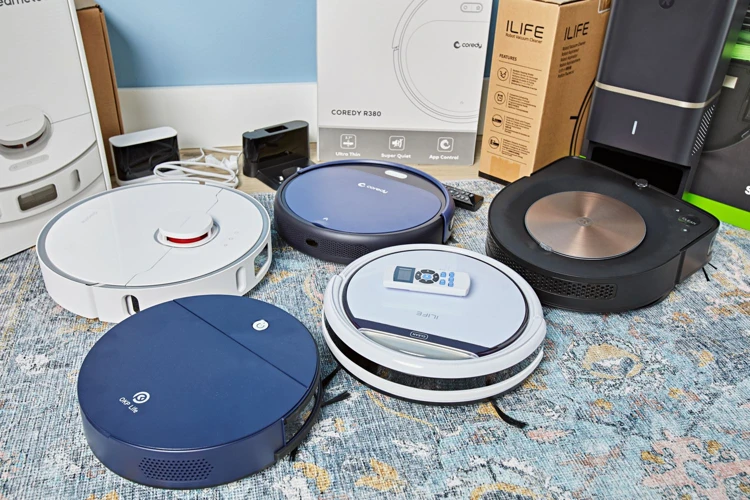
One important component of your multi-floor robot vacuum cleaner that requires special attention is its battery. The battery is what powers the vacuum and allows it to move around your home, which means it’s crucial to ensure that it’s well cared for. Without proper care, your vacuum’s battery can malfunction, leading to shortened lifespan and reduced performance. In this section, we’ll discuss the best ways to care for your robot vacuum battery and keep it performing optimally for longer.
Avoid Overcharging the Battery
One of the most important aspects of caring for your multi-floor robot vacuum cleaner is properly maintaining its battery. Overcharging your vacuum’s battery can cause irreversible damage, so it’s essential to know how to avoid overcharging it.
What is overcharging?
Overcharging occurs when you leave your robot vacuum’s battery charging for longer than recommended by the manufacturer. When a battery is overcharged, heat is generated inside the battery, causing it to degrade and lose its ability to hold a charge. This can lead to a shortened battery life and potentially expensive repairs.
How to avoid overcharging your robot vacuum’s battery
To ensure that you don’t overcharge your robot vacuum’s battery, it’s important to follow these tips:
| Tips to avoid overcharging your robot vacuum’s battery |
|---|
| Read the manufacturer’s instructions carefully to determine the optimal charging time for your vacuum’s battery. |
| Set a timer or use a smart plug to ensure that your robot vacuum stops charging after the recommended time. |
| Avoid leaving your robot vacuum on the charger for prolonged periods of time, such as overnight. |
| Don’t let your robot vacuum’s battery drain completely before charging it, as this can also damage the battery. |
| If you’re going to store your robot vacuum for an extended period of time, make sure it has a partial charge (around 50%) before storing it. |
Why is proper battery maintenance important?
Proper battery maintenance is important because it can help prolong the life of your vacuum and save you money in the long run. A well-maintained battery will hold its charge longer, giving your robot vacuum more cleaning power. Additionally, a poorly maintained battery can lead to more frequent replacements, which can be costly. By practicing good battery habits, you’ll be able to keep your robot vacuum operating at peak performance for years to come.
Store the Robot Vacuum Properly
After you’ve charged your multi-floor robot vacuum cleaner, it’s important to store it properly to avoid any damage to the battery or other components. Here are some tips for storing your robot vacuum:
Avoid Direct Sunlight: Direct sunlight can damage the vacuum’s electronics and battery. Store it in a cool, dry place away from direct sunlight.
Turn it Off: Make sure to turn off your robot vacuum before storing it. This will prevent any unnecessary drain on the battery.
Remove the Battery: If you plan on storing your robot vacuum for an extended period of time, consider removing the battery. This will prevent any potential damage to the battery and extend its overall lifespan.
Use the Original Box: If you still have the original packaging, use it to store your robot vacuum. The box will protect the vacuum from dust and any other potential hazards.
Clean the Vacuum: Before storing your robot vacuum, make sure to clean it thoroughly. Empty the dustbin and clean the brushes and filters. This will prevent any dirt or debris from accumulating and potentially damaging the vacuum.
| Do: | Don’t: |
|---|---|
| Store the vacuum in a cool, dry place | Store the vacuum in direct sunlight |
| Turn off the vacuum before storing it | Leave the vacuum on while storing it |
| Consider removing the battery if storing for an extended period | Leave the battery in if not planning to use for a long time |
| Use the original packaging if available | Store the vacuum uncovered or in an unsuitable container |
| Clean the vacuum before storing it | Store the vacuum with a dirty dustbin or uncleaned filters |
By following these simple steps, you can ensure that your multi-floor robot vacuum cleaner stays in top condition and provides optimal cleaning performance for years to come.
Troubleshooting Common Issues with Your Multi-Floor Robot Vacuum Cleaner
Is your multi-floor robot vacuum cleaner giving you trouble? Don’t worry, even the most high-quality and expensive robot vacuums can have issues from time to time. The key is to identify the problem and troubleshoot it accordingly. In this section, we will discuss some common issues that you may encounter with your multi-floor robot vacuum cleaner and provide you with some tips and tricks on how to fix them. By the end of this section, you’ll be equipped with the knowledge to keep your robot vacuum running smoothly and efficiently.
Vacuum is not Charging
If your multi-floor robot vacuum cleaner is not charging properly, it can be quite frustrating. However, before you panic and consider buying a new vacuum, there are few simple things you can do to troubleshoot and fix the issue. Here are some steps you can take:
- Check the power source: Firstly, make sure the charging station is properly plugged in and the power outlet is functioning. If possible, try plugging the dock into a different outlet to see if that solves the problem.
- Check the charging contacts: The charging contacts on both the vacuum and docking station should be clean and free from any debris. Use a dry cloth or brush to clean them gently.
- Check the battery: If the battery is completely drained, the vacuum may take some time to charge before it starts working. Wait for a few hours to see if the vacuum starts to charge. If the battery is severely old and damaged, it may require replacement.
- Check the charging pins: Make sure that the charging pins on the vacuum and the docking station are properly aligned. A misalignment can cause the vacuum to improperly charge.
- Check the charging station: If the above steps don’t help, try charging another device on the same dock to see if the charging station is the issue.
By following these simple steps, you can ensure that your multi-floor robot vacuum cleaner is charging properly and ready for use when you need it. If none of the above steps work, it may be time to contact the manufacturer for further assistance.
Vacuum is not Cleaning or Suction is Weak
If you notice that your multi-floor robot vacuum cleaner is not cleaning as efficiently as it was before, or if the suction power seems weak, it may be time to perform some maintenance and troubleshooting. Here are some steps you can follow to fix the problem:
1. Check the Dustbin and Filters: The first thing you should do is check the dustbin and filters. If they are full or clogged, they can reduce suction power. Empty the dustbin and clean or replace the filters if necessary.
2. Inspect the Brushes: The brushes in your robot vacuum cleaner might be clogged with hair, dust, or debris. Check and clean the brushes manually. If they are worn out, replace them.
3. Examine the Wheels and Tires: If the wheels and tires are not clean, they can affect the vacuum’s ability to move smoothly around your floors. Make sure they are clean and free of any debris.
4. Clean the Sensors: Your robot vacuum cleaner uses sensors to navigate your home. If they are dirty or obstructed, they can cause the vacuum to malfunction. Use a clean, dry cloth to wipe the sensors.
5. Reset the Robot Vacuum Cleaner: If none of the above solutions work, try resetting the robot vacuum cleaner. This is a simple process, typically involves holding down the power button or performing a factory reset.
By following these steps, you should be able to fix the problem of weak suction and ensure your robot vacuum cleaner is working optimally. If you continue to experience the same issue after performing these steps, you may need to contact customer support for additional help or assistance.
Vacuum is Getting Stuck or Falling Down Stairs
If your multi-floor robot vacuum cleaner is getting stuck or falling down stairs, don’t worry. There are several things you can do to troubleshoot the issue and get your vacuum back on track.
1. Clear the Obstacles
One common reason your vacuum may be getting stuck is because of obstacles in its path. Clearing any clutter or furniture out of the way can prevent your vacuum from getting stuck and help it move more freely around your home.
2. Adjust the Sensors
If your vacuum is still getting stuck even after clearing the obstacles, you may need to adjust the sensors. Check the manual for your specific vacuum to see if there are any instructions on how to adjust the sensors. Some vacuums have sensors that can be adjusted manually, while others may need to be reset.
3. Clean the Wheels and Tires
The wheels and tires of your vacuum can become clogged with dirt and debris, which can cause it to get stuck. Regularly cleaning the wheels and tires can help prevent this issue from occurring.
4. Check the Battery
A low battery can cause your vacuum to get stuck or fall down stairs. Make sure your vacuum is fully charged before each use, and consider replacing the battery if it is old or damaged.
5. Reset the Vacuum
If none of the above solutions work, try resetting the vacuum. Refer to the manual for instructions on how to reset your specific vacuum.
By following these tips, you can troubleshoot and fix the issue of your multi-floor robot vacuum cleaner getting stuck or falling down stairs.
Conclusion
In conclusion, proper maintenance and care are crucial for ensuring the longevity and optimal performance of your multi-floor robot vacuum cleaner. By taking the necessary steps to keep your vacuum clean and well-maintained, you can avoid common issues and keep your home healthy and dust-free.
Remember to regularly empty the dustbin, clean the brushes and filters, and keep the sensors and charging station clean. Additionally, inspect the wheels and tires to ensure that your vacuum can move around your floors without any issues.
Taking care of your vacuum’s battery is also important. Avoid overcharging the battery and store your vacuum properly in a dry and cool place.
If you encounter any issues with your multi-floor robot vacuum cleaner, don’t panic. Troubleshoot the problem by checking the charging, suction, and movement components, and use the manual to help you resolve the issue.
By investing in the proper maintenance and care of your multi-floor robot vacuum cleaner, you can prolong its lifespan and keep your home clean and healthy. So, follow these tips and enjoy a hassle-free and efficient cleaning schedule that will make your life easier and more enjoyable.
Frequently Asked Questions
Can I use my multi-floor robot vacuum cleaner on carpeted floors?
Absolutely. Multi-floor robot vacuum cleaners are designed to be used on a variety of surfaces, including carpeted ones.
How often do I need to empty the dustbin on my multi-floor robot vacuum cleaner?
It depends on how much your vacuum is used, but it’s a good idea to empty the dustbin after every use to ensure optimal performance.
Do I need to clean the brushes and filters on my multi-floor robot vacuum cleaner?
Yes, it’s important to clean the brushes and filters regularly to keep the vacuum functioning properly.
How do I clean the sensors on my multi-floor robot vacuum cleaner?
You can use a soft, dry cloth or cotton swab to gently clean the sensors. Avoid using water or cleaning solutions.
What type of cleaning agent should I use to clean my multi-floor robot vacuum cleaner?
It’s best to avoid using any type of cleaning agent. Instead, use a soft, dry cloth to wipe down the vacuum’s surfaces.
Is it safe to leave my multi-floor robot vacuum cleaner charging overnight?
Avoid leaving your vacuum charging overnight as it can cause the battery to overheat and reduce its lifespan.
How do I store my multi-floor robot vacuum cleaner when not in use?
Store the vacuum in a cool, dry place away from direct sunlight. Avoid storing it in places with extreme temperatures or humidity.
Can I replace the battery on my multi-floor robot vacuum cleaner?
Most robot vacuums have replaceable batteries, but it’s best to check with the manufacturer or refer to the user manual for instructions.
What should I do if my multi-floor robot vacuum cleaner gets stuck or falls down stairs?
Check to ensure that the sensors are clean and not blocked by any debris. If the issue persists, contact the manufacturer’s customer service for assistance.
What is the average lifespan of a multi-floor robot vacuum cleaner?
The lifespan of a robot vacuum cleaner can vary depending on usage, maintenance, and the quality of the vacuum. On average, most last between 2-5 years.
